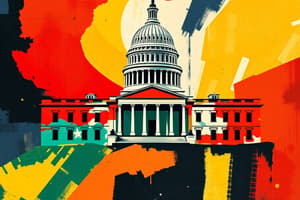Podcast
Questions and Answers
Which of the following is NOT a primary role of federal and provincial governments in Canada?
Which of the following is NOT a primary role of federal and provincial governments in Canada?
- Influencing public opinion through media campaigns. (correct)
- Addressing pollution-related issues.
- Making decisions on healthcare policies.
- Determining military spending allocations.
Which branch of the Canadian government is responsible for interpreting laws and imposing penalties?
Which branch of the Canadian government is responsible for interpreting laws and imposing penalties?
- Parliament
- Legislative Branch
- Judicial Branch (correct)
- Executive Branch
Who leads the country, represents Canada abroad, recommends judges and senators, and can call elections?
Who leads the country, represents Canada abroad, recommends judges and senators, and can call elections?
- Governor General
- Prime Minister (correct)
- Cabinet Minister
- Lieutenant Governor
What is the role of the Senate within the Legislative Branch of the Canadian government?
What is the role of the Senate within the Legislative Branch of the Canadian government?
In Canada's political system, what is the significance of 'ridings'?
In Canada's political system, what is the significance of 'ridings'?
What role does the Opposition Leader play in ensuring government accountability?
What role does the Opposition Leader play in ensuring government accountability?
What is the first step in the law-making process in Canada?
What is the first step in the law-making process in Canada?
Which statement accurately describes the relationship between the judiciary and the government in Canada?
Which statement accurately describes the relationship between the judiciary and the government in Canada?
Which court serves as the final authority on legal matters in Canada?
Which court serves as the final authority on legal matters in Canada?
Which of the following is a major federal political party in Canada?
Which of the following is a major federal political party in Canada?
What is the main goal of Canada's government structure?
What is the main goal of Canada's government structure?
Which branch of government is responsible for implementing government policies and programs?
Which branch of government is responsible for implementing government policies and programs?
Which of the following is primarily the responsibility of the Legislative Branch (Parliament)?
Which of the following is primarily the responsibility of the Legislative Branch (Parliament)?
What differentiates the provincial Executive Branch from the federal Executive Branch in Canada?
What differentiates the provincial Executive Branch from the federal Executive Branch in Canada?
What is the term used for elected members of the House of Commons?
What is the term used for elected members of the House of Commons?
What is the role of civil and criminal courts within the Judiciary?
What is the role of civil and criminal courts within the Judiciary?
Which of the following statements best describes how laws are passed in Canada?
Which of the following statements best describes how laws are passed in Canada?
In the Canadian political system, which entity ensures government accountability?
In the Canadian political system, which entity ensures government accountability?
What are the three branches of the Canadian government that work together to govern fairly and uphold democracy?
What are the three branches of the Canadian government that work together to govern fairly and uphold democracy?
Why is the judicial system considered independent from the government in Canada?
Why is the judicial system considered independent from the government in Canada?
Flashcards
Canadian Gov Structure
Canadian Gov Structure
Federal and provincial governments shape laws and political representation.
Govt. Responsibilities
Govt. Responsibilities
Federal and provincial governments decide on education, healthcare, pollution and military spending.
Judicial Branch Role
Judicial Branch Role
Judges interpret laws and impose penalties.
Judicial Courts
Judicial Courts
Signup and view all the flashcards
Executive Branch Function
Executive Branch Function
Signup and view all the flashcards
Federal Executive Roles
Federal Executive Roles
Signup and view all the flashcards
Provincial Executive Branch
Provincial Executive Branch
Signup and view all the flashcards
Legislative Branch Role
Legislative Branch Role
Signup and view all the flashcards
House of Commons Function
House of Commons Function
Signup and view all the flashcards
Senate Role
Senate Role
Signup and view all the flashcards
Political party Roles
Political party Roles
Signup and view all the flashcards
Ridings (electoral districts)
Ridings (electoral districts)
Signup and view all the flashcards
Opposition Leader Role
Opposition Leader Role
Signup and view all the flashcards
Law-Making Process Summary
Law-Making Process Summary
Signup and view all the flashcards
Judicial System Principle
Judicial System Principle
Signup and view all the flashcards
Types of Courts
Types of Courts
Signup and view all the flashcards
Supreme Court Power
Supreme Court Power
Signup and view all the flashcards
Major Federal Parties
Major Federal Parties
Signup and view all the flashcards
Government Goal
Government Goal
Signup and view all the flashcards
Branches Working Together
Branches Working Together
Signup and view all the flashcards
Study Notes
- Canada's federal and provincial governments' structure and functions, how laws are made, and how political representation works are explained
Role of Federal and Provincial Governments
- Decisions are made about education, healthcare, pollution, military spending, and other issues
- Public opinion, legal decisions, and changing circumstances influence government actions
Three Branches of Government
- The three branches of government are the judicial, executive and legislative
Judicial Branch
- Judges and courts interpret laws and impose penalties
- Federal and provincial courts are included in the Judicial Branch
- The Supreme Court of Canada is the highest authority
Executive Branch
- Government policies and programs are implemented
- At the federal level, the Executive Branch is comprised of the Prime Minister, Governor General, Cabinet Ministers, and Public Service
- A Lieutenant Governor is at the provincial level instead of a Governor General
- The Prime Minister leads the country and represents Canada abroad
- The Canadian Prime Minister recommends judges and senators, and can call elections
Legislative Branch (Parliament)
- The Legislative Branch creates and modifies laws
- The Legislative Branch includes the House of Commons and the Senate
- Elected Members of Parliament (MPs) debate and vote on laws in the House of Commons
- Appointed senators review and amend laws in the Senate
Political System and Elections
- Political parties compete in elections
- Canada has 338 ridings (electoral districts)
- The candidate with the most votes in each riding becomes an MP
- The Opposition Leader (from the second-largest party) ensures government accountability
Law-Making Process
- Laws start as bills, which are debated in Parliament
- Bills are passed by both the House of Commons and Senate before becoming law
The Judiciary
- The judicial system is independent from the government
- Civil courts (rights disputes) and criminal courts (offenses against society) are included
- The Supreme Court is the final authority on legal matters
Political Parties and Representation
- The major federal parties are the Liberal, Conservative, NDP, Bloc Québécois, and Green Party
- Provincial politics has similar party structures but different leaders
Conclusion
- Canada's government balances power, accountability, and citizen representation
- The executive, legislative, and judicial branches work together to govern fairly and uphold democracy
Studying That Suits You
Use AI to generate personalized quizzes and flashcards to suit your learning preferences.




